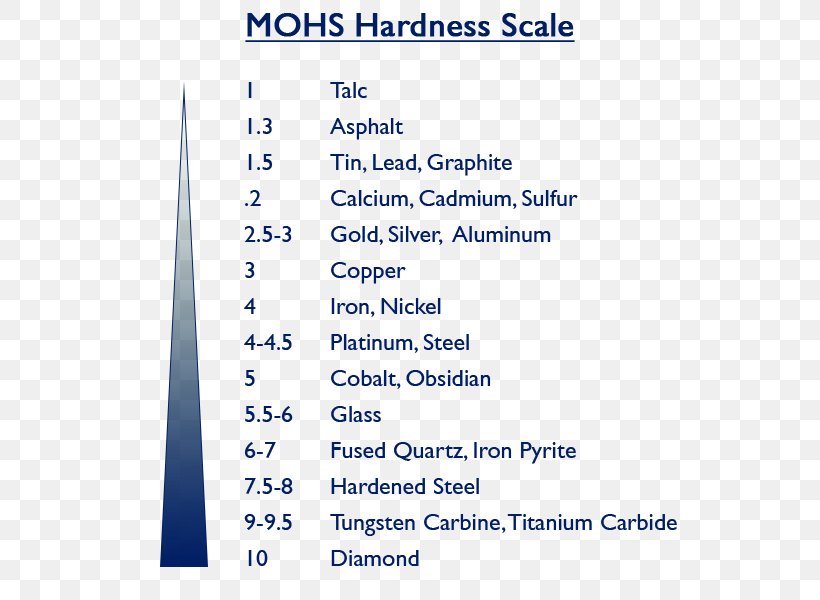
Mohs Scale Of Mineral Hardness Hardness Comparison Hardened Steel, PNG
April 25, 2018. This metal hardness chart organizes different types of metal using the Mohs hardness scale, a metric used by scientists to determine the scratch resistance of different minerals. With diamond at the top of the scale at a score of 10, elements and alloys can fall along the metal hardness scale from 10 (the most scratch-resistant.

Mohs Hardness Scale r/PhoenixSC
The Mohs hardness scale is a qualitative test that measures the hardness of a mineral by its ability to visibly scratch softer minerals. The scale isn't perfect, but it's a great tool for quick identification of rocks in the field.. topaz, cubic zirconia, spinel, hardened steel: 8.5: chrysoberyl, silicon nitride, tantalum carbide.

A Guide to the Mohs Scale In the Know Ethica Diamonds UK
The Mohs scale is a system used to rank materials on their hardness, which is graded using numbers from 1 to 10. It can be used to compare gemstones, metals and other materials, and evaluate their relative durability. Where a metal stands on the Mohs scale indicates which other metals can scratch it.

The Mohs Scale of Hardness Explained YouTube
The name's Mohs, not Moh or Moh's. - andselisk ♦ Jan 22, 2022 at 23:11 Add a comment 1 Answer Sorted by: 7 You can find Mohs hardness values for various pure metals, but it sounds like you want something more specialized: Mols hardness values for specific alloys. That's probably harder to find.
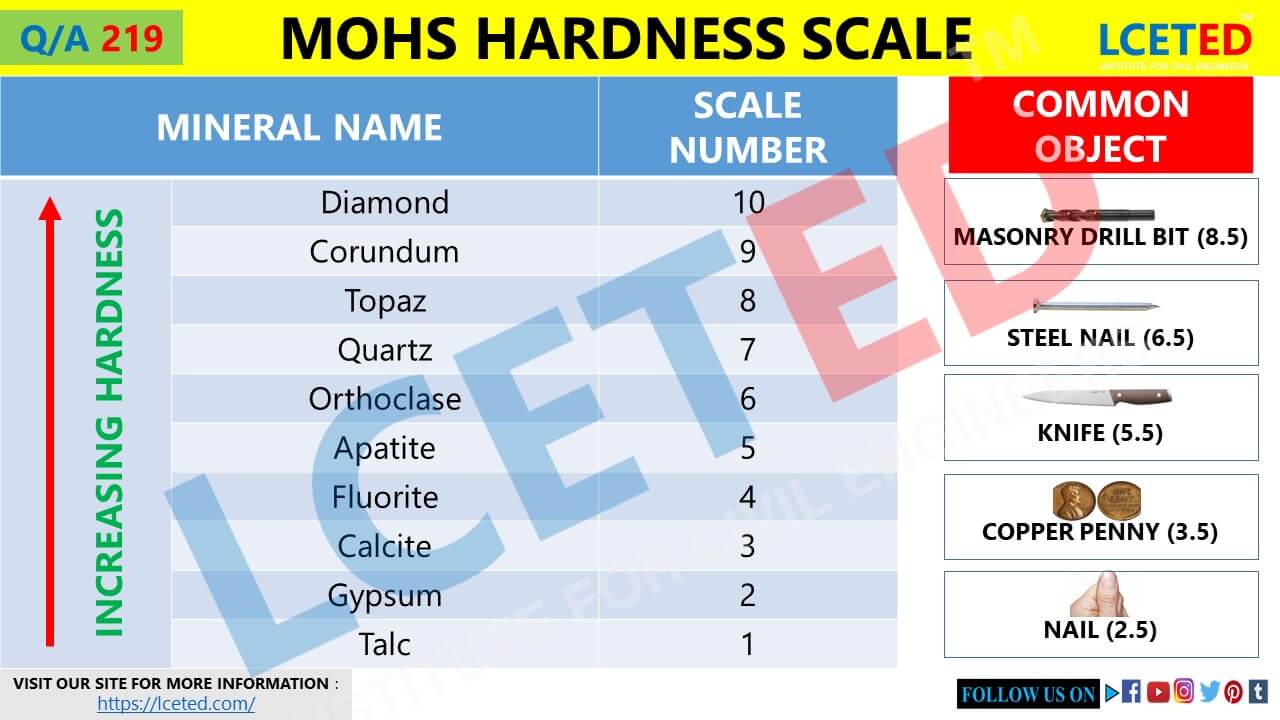
What Is Mohs Scale Of Hardness? And How To Use It lceted LCETED
ADVERTISEMENT What is Mohs Hardness Scale? The Mohs Hardness Scale is a set of ten reference minerals (numbered 1 through 10) that are used to determine the relative hardness of minerals and other objects. In this test the hardness of a mineral is defined as its "resistance to being scratched".
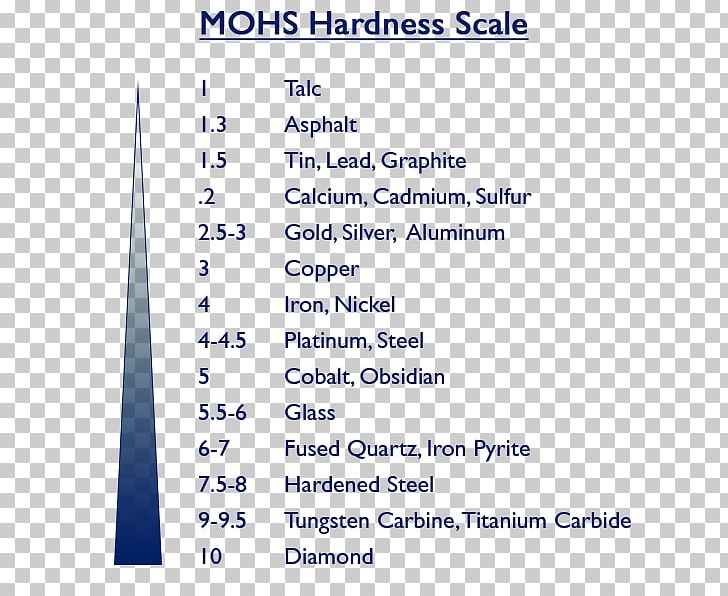
Mohs Scale Of Mineral Hardness Hardness Comparison Hardened Steel PNG
Because of low Mohs hardness, ZnS pigments cause virtually no wear on moulds and do not impair the mechanical strength of fibre-reinforced plastics (in contrast to abrasive pigments such as TiO2 ). Their main applications are in thermosetting compounds, glass fibre-reinforced thermosets and thermoplastics, and polyolefins. Table 7.3.
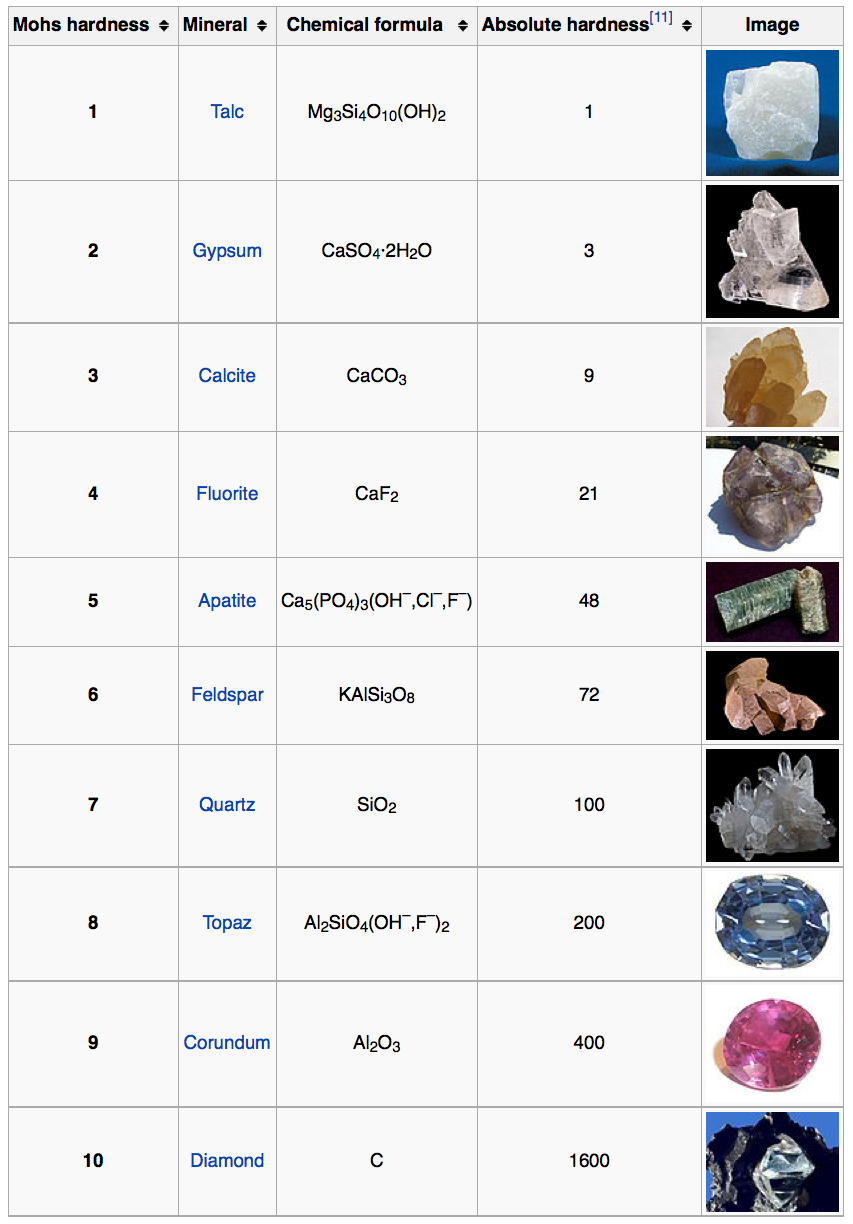
What Is the Mohs Scale? — Reclaim, Recycle, and Sell your Precious
The Mohs hardness scale. Image credit: Philip Brayne for IFLScience Since then, other substances have been added using decimals. This guide, for example, slots in such relevant items as nails,.

Updated Mohs' Hardness Scale stevenuniverse
The Brinell hardness test uses a ball made of hardened steel or a hard alloy with a diameter of D as the indenter. A specified test force F is applied to the surface of the material being tested, and after a designated hold time, the test force is removed, leaving an indentation with a diameter of d.
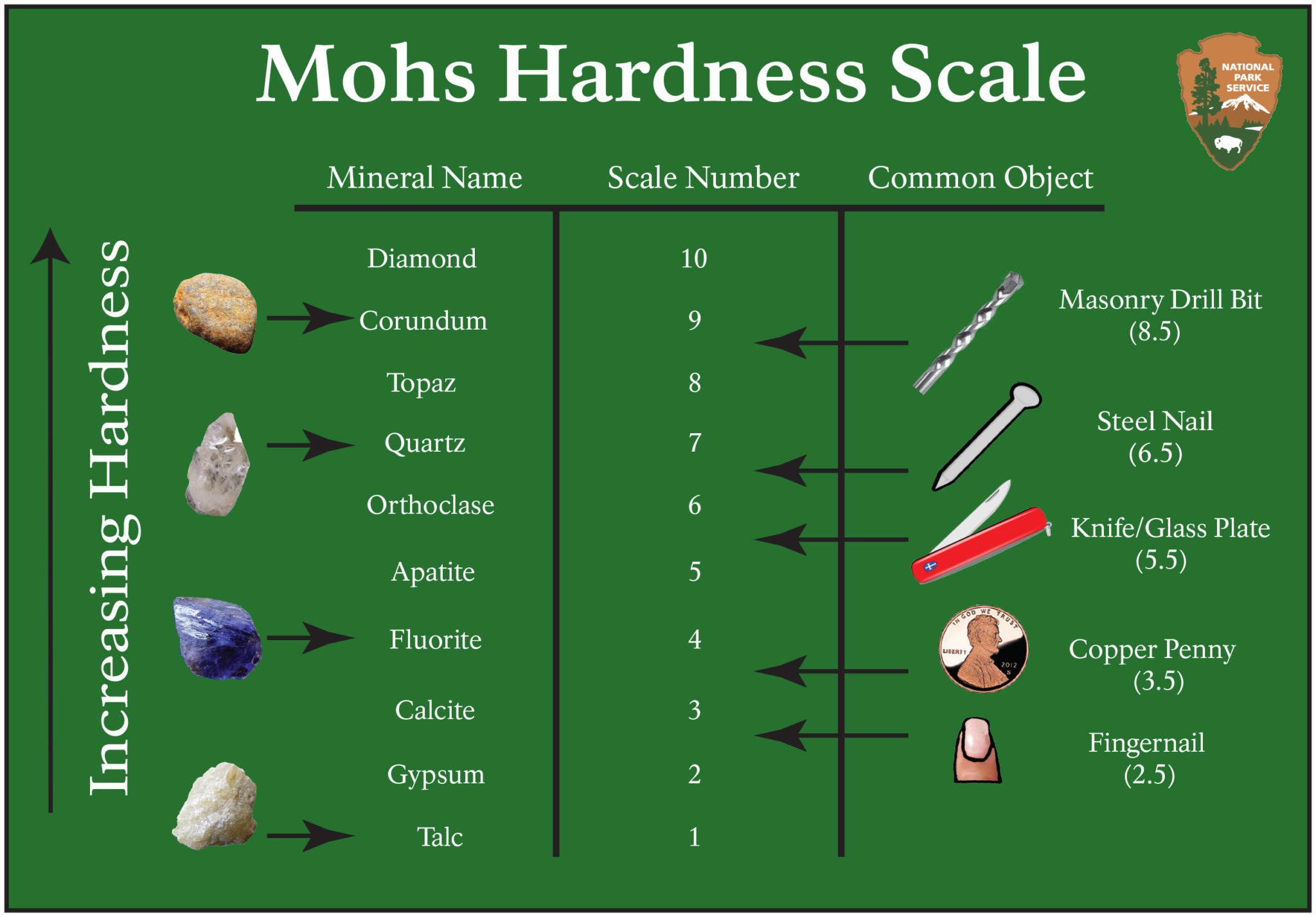
Moh's Hardness Scale International Granite And Stone
The Mohs scale of mineral hardness ( / moʊz /) is a qualitative ordinal scale, from 1 to 10, characterizing scratch resistance of minerals through the ability of harder material to scratch softer material.

Mohs hardness scale Stock Image C010/9147 Science Photo Library
The Mohs hardness scale is based on ten minerals of different hardness, divided into ten levels from low to high: 1. Talc; 2. Gypsum; 3. Calcite; 4. Fluorite; 5. Apatite; 6. Orthoclase; 7. Quartz; 8. Topaz; 9. Corundum; 10. Diamond. In use, standard minerals are scratched against minerals of unknown hardness.

Mohs Hardness Scale
For instance, metals like gold (Mohs hardness 2.5-3) and copper (Mohs hardness 3) are softer, while steel and iron (Mohs hardness 4-4.5) have intermediate hardness, and tungsten carbide (Mohs hardness ≥9) is one of the hardest materials. These metals can be used to scratch rocks to determine their hardness approximately and aid in identifying.

Infographic Mohs Hardness Scale of Metals 20180425 Industrial
It consists of a steel ball dropped from a fixed height. This type of hardness is related to elasticity. Within each of these classes of measurement there are individual measurement scales. For practical reasons conversion tables are used to convert between one scale and another. Measuring Hardness
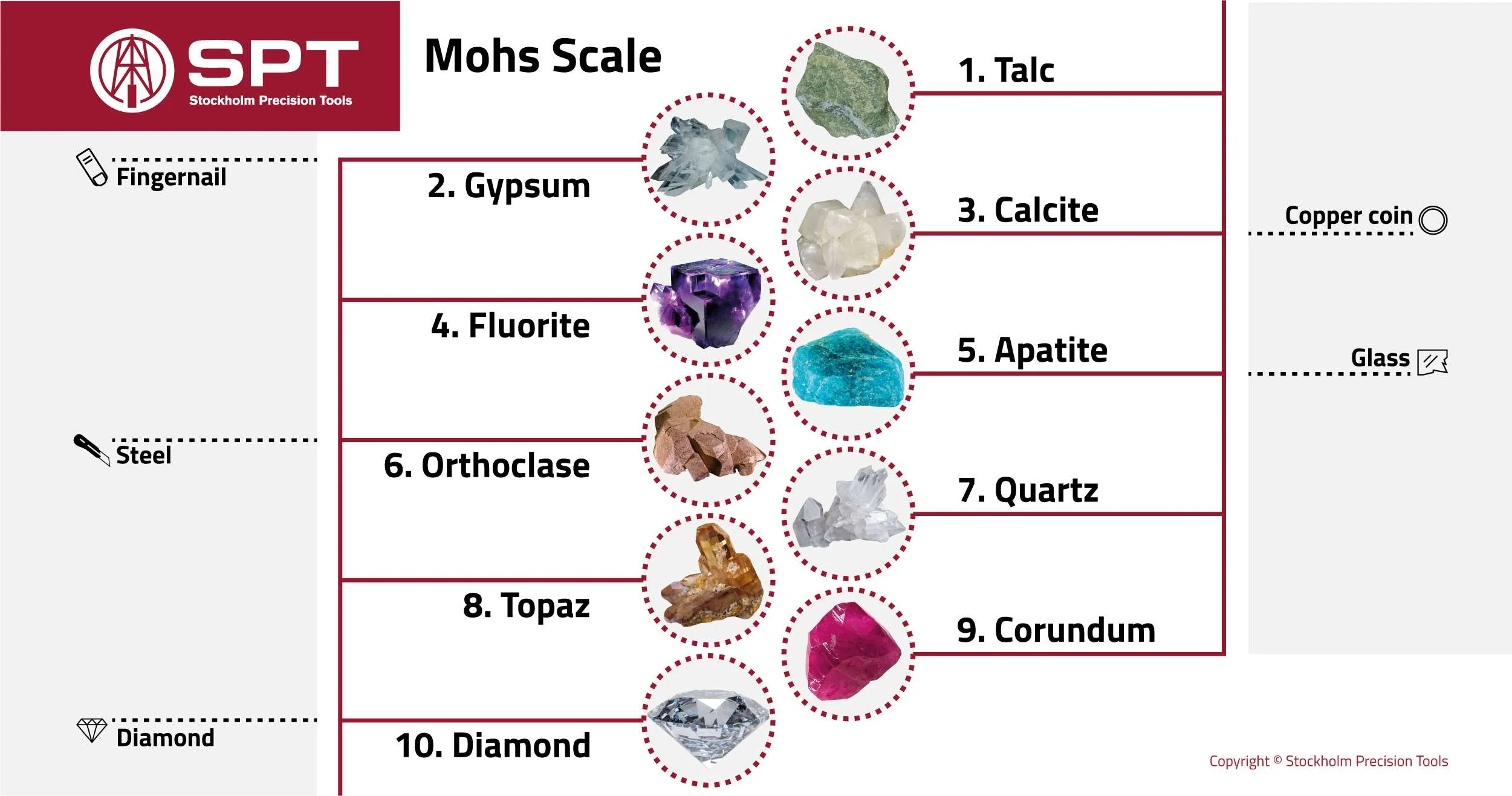
The Mohs Scale to define the hardness of minerals
Mohs scale of mineral hardness; Mohs hardness of materials (data page) Vickers hardness test; Brinell scale This page was last edited on 14 September 2023, at 23:16 (UTC). Text is available under the Creative Commons Attribution-ShareAlike License 4.0; additional terms may apply. By using this site, you.

Infographic Mohs Hardness Scale of Metals 20180425 Industrial
Hardness Hardness is the resistance of a material to the penetration of another, harder body. Hard-ness is also a measure of the wear resistance of steel. The hardness property is required 3.1 Properties of Steel. 66 3 Alloying Elements and Steel Properties for those components that are exposed to large forces and high wear, such as gears, roll-
.jpg)
The Mohs Hardness Scale Geology In
Mohs hardness, rough measure of the resistance of a smooth surface to scratching or abrasion, expressed in terms of a scale devised (1812) by the German mineralogist Friedrich Mohs. The Mohs hardness of a mineral is determined by observing whether its surface is scratched by a substance of known or defined hardness.

Mohs scale of mineral hardness Steel Steel Choices
Hardness: This is measured with the Mohs scale and refers to the minerals contained within a rock. In simple terms, hard rock scratches glass and steel, usually signifying the minerals quartz or feldspar, which has a Mohs hardness of 6 or higher. Soft rock does not scratch steel but will scratch fingernails (Mohs scale of 3 to 5.5), while very.